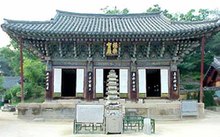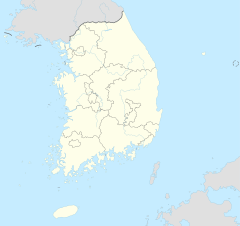Three portraits in Josadong
Josadong is the oldest building at Shilleuk-sa. Built to pay tribute to Buddhist priests Naong (c. 1320–1376), Muhak (c. 1327–1405), and Jigong (d. 1363), it enshrines their portraits.
Ordained at the age of 20, master Naong spent ten years in China. He became a celebrated Zen master whose teaching methods integrated chanting, for him a state of mind in which obtrusive thinking became absent. He purportedly planted the temple's 600 year-old ginkgo tree.
Master Muhak was an advisor to Yi Seong-gye who became King Taejo, the founder of the Joseon dynasty. It is thought that Muhak's reputation as a geomancer influenced Yi's decision to move the capital from Gaeseong to Hanyang (present-day Seoul).
Arriving in Korea circa 1328, master Jigong was an Indian monk whose Sanskrit name was Dhyānabhadra. Following his death in China, his remains were returned to the temple.

Korean Buddhism is distinguished from other forms of Buddhism by its attempt to resolve what its early practitioners saw as inconsistencies within the Mahayana Buddhist traditions that they received from foreign countries. To address this, they developed a new holistic approach to Buddhism that became a distinct form, an approach characteristic of virtually all major Korean thinkers. The resulting variation is called Tongbulgyo, a form that sought to harmonize previously arising disputes among scholars.
Buddhist temples are an important part of the Korean landscape. Most Korean temples have names ending in -sa, which means "monastery" in Sino-Korean. Many temples participate in the Templestay program, where visitors can experience Buddhist culture and even stay at the temple overnight.

Bulguksa (Korean: 불국사) is a Buddhist temple on Tohamsan, in Jinhyeon-dong, Gyeongju, North Gyeongsang Province, South Korea.

Tongdosa is a head temple of the Jogye Order of Korean Buddhism and in the southern part of Mt. Chiseosan near Yangsan, South Gyeongsang Province, South Korea.

Yeoju is a city in Gyeonggi Province, South Korea. Yeoju was a county but was raised to the status of a city in September 2013. Together with the neighboring city of Icheon, it is known as a major center of contemporary South Korean ceramics, and hosts the World Ceramic Exposition every year. Other local products of note include rice, sweet potatoes, and yellow melons. Yeoju is the birthplace of Korea's last queen, Empress Myeongseong.

National Treasure (Korean: 국보) is a national-level designation within the heritage preservation system of South Korea for tangible objects of significant artistic, cultural and historical value. Examples of objects include art, artifacts, sites, or buildings. It is administered by the Cultural Heritage Administration (CHA). Additions to the list are decided by the Cultural Heritage Committee.
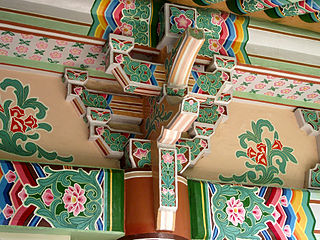
Korean architecture refers to an architectural style that developed over centuries in Korea. Throughout the history of Korea, various kingdoms and royal dynasties have developed a unique style of architecture with influences from Buddhism and Korean Confucianism.
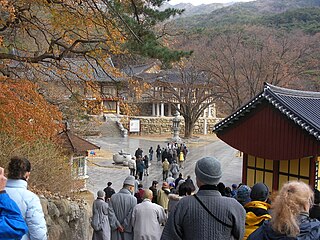
Donghwasa (Korean: 동화사), also Donghwa Temple, is a Buddhist temple of the Jogye Order in northern Daegu, South Korea. The temple is located on the south side of Mt. Palgongsan, within the boundaries of Dohak-dong, Dong-gu, near Daegu's northern border. The name means "Temple of Paulownia Blossoms."

Jogyesa is the chief temple of the Jogye Order of Korean Buddhism. The building dates back to the late 14th century and became the order's chief temple in 1936. It thus plays a leading role in the current state of Seon Buddhism in South Korea. The temple was first established in 1395, at the dawn of the Joseon Dynasty; the modern temple was founded in 1910 and initially called "Gakhwangsa". The name was changed to "Taegosa" during the period of Japanese rule, and then to the present name in 1954.
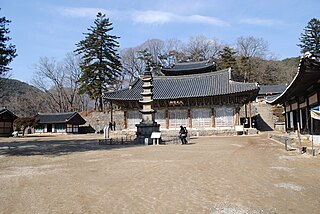
Magoksa is a head temple of the Jogye Order of Korean Buddhism in Gongju, South Korea. It is located on the eastern slope of Taehwasan, on taegeuk-shaped bend in the Taegeukcheon Stream.

Beopjusa, is a head temple of the Jogye Order of Korean Buddhism. It is situated on the slopes of Songnisan, within Songnisan National Park, in Naesongni-myeon, Boeun County, in the province of Chungcheongbuk-do, South Korea.

Woljeongsa (Korean: 월정사) is a head temple of the Jogye Order of Korean Buddhism, located on the eastern slopes of Odaesan in Pyeongchang County, Gangwon Province, South Korea. Woljeongsa was founded in 643 by the Silla monk Jajang.

Geumsansa is a temple of the Jogye Order of Korean Buddhism standing on the slopes of Moaksan in Gimje City, Jeollabuk-do, South Korea.

Unjusa or Unju Temple is a Korean Buddhist temple located in Hwasun County, South Jeolla province, South Korea. It is 26 km (16 mi) southwest of Hwasun County or 40 km (24 mi) south of Gwangju. Compared with other temples in South Korea, this temple has an unusual collection of stone Buddha statues and stone pagodas, so Unjusa is often referred to as the mysterious temple. Among several assumptions regarding its origin, the most widely known one is that Monk Doseon founded the temple based on geomancy during the late period of Silla Dynasty, but the origins remain unverified.

Bongjeongsa is a Korean Buddhist temple on the slopes of Mount Cheondeung in Andong city, North Gyeongsang Province, South Korea. It is a subsidiary temple of Gounsa, the head temple of the 16th branch of Jogye Order.

Geumdangsa or Geumdang Temple is a South Korean Buddhist temple in the Maisan in Jinan County, North Jeolla Province, South Korea.
Geonbongsa (Korean: 건봉사) is a temple located in Goseong County, Gangwon Province, South Korea.
Muhak was a Korean Buddhist monk that lived during the transition between the Goryeo and the Joseon kingdoms.

Naesosa (Korean: 내소사), or Naeso Temple, is a Korean Buddhist temple located at the base of the mountain Naebyeongsan in Jinseo-myeon, Buan County, Jeonbuk State, South Korea.

Yongmunsa is a Buddhist temple of the Jogye Order in Yangpyeong county, South Korea.
